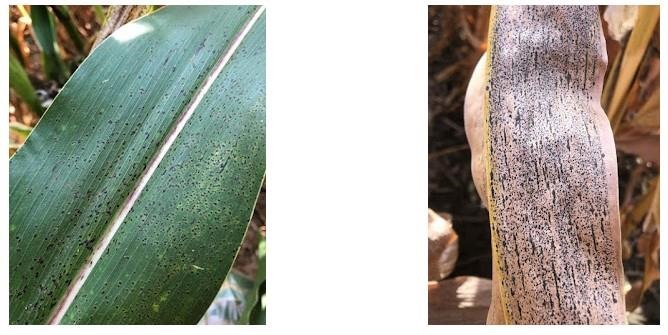By Dean Malvick
Tar spot of corn increased in distribution and severity in Minnesota in 2021 compared to previous years. It developed widely in SE MN where it developed previously, and spread west and north to areas where it was not previously known. Thus, tar spot is no longer restricted to southeast Minnesota and may pose a risk to more areas in the future.

Tar spot is a fungal disease of corn that primarily infects and damages leaves. It can result in significant yield losses, depending on weather, severity, and timing of disease development. Risk of disease is highest in areas with frequent rains where the disease has occurred previously. Corn tar spot is caused by the fungus Phyllachora maydis. It produces raised, small (0.1” – 0.2”) raised, irregular-shaped black structures on leaves. The black structures are firm, appear mostly smooth on the surface, and do not rub off or break open (see photos below from MN corn fields).

Key points and observations from 2021
The first report that I have of tar spot in MN in 2021 was the last week of July in Fillmore County.
- Since then, tar spot developed across SE MN and spread much further to the north and west.
- Tar spot was widespread in fields and most severe in SE MN where the disease was established in previous years and rains were more common this summer than in other areas.
- Even in SE MN, tar spot was at low levels in most fields until late August and September, and it had no effect on corn yields. However, yield loss due to tar spot was likely in some fields.
- The map above shows the confirmed distribution of tar spot in MN. Tar spot probably also spread to other counties where it was not detected or was unreported.
- How is tar spot spreading? Spread via wind seems likely, but we do not know how far it can spread. For example, I found tar spot in September in late-planted corn plots on the St Paul campus. As most of you know, there are no nearby corn fields. Did it travel via wind more than 10 miles from the nearest large corn fields, or did it make short jumps on garden plots across the suburbs and city to campus? Tar spot also likely spreads by infested residue.
- The distribution map for tar spot in MN shows spread of the disease to the north and west. Most of the counties with new finds of tar spot had very low levels of disease when it was observed in September and October. Tar spot probably started in many of those fields in early to mid-September following the rains.
- The disease did not affect yield outside of SE MN. This is likely due to late development of disease, possibly due to dry conditions and the lack of local inoculum to start the disease.
- We cannot predict what will happen with tar spot in Minnesota in the future, although it may now be established in many areas and pose an increased risk to corn crops.
- Not only did tar spot spread in MN, it also spread in many other states and developed to severe levels in many areas. A map with the known distribution of tar spot in the U.S. is available from Corn ipmPipe.
Source : umn.edu